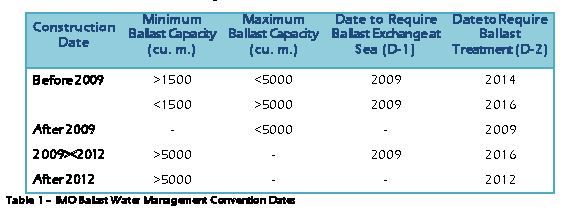Ballast Water Management

Tanker De-Ballasting
The International Maritime Organization, in February 2004, set forth regulations to promote a stricter control of the transfer of invasive species in ballast water and released the Convention for the Control and Management of Ship’s Ballast Water and Sediments (the Ballast Water Management Convention). The Convention will require the vessels to develop a Ballast Water Management Plan which complies with the Convention’s standards, carry a Ballast Water Record Book and conduct ballast water management in accordance with the timetable given below in Table 1:
This Convention will be binding to all Administrations (that is, all countries which have merchant fleets) 12 months after 30 countries and at least 35 percent of the world’s shipping tonnage ratify the Convention. Currently, 33 nations have ratified the Convention representing 30.4 percent (0.304) of the world’s shipping tonnage. This implies that ballast water exchange is still the primary control on invasive species.
Ballast water exchange at sea (Regulation D-1) is to be carried out in a water depth of at least 200 meters (about 660 feet) and not closer than 50 nautical miles from the nearest land. Ballast water exchange was considered an interim solution to ballast water management as evidenced by the chart above; it is to allow for the development of ballast water treatment equipment meeting the Performance Standards of the Convention.
Once the ship is required to have a ballast water treatment (Regulation D-2) in its Ballast Water Management Plan, the treatment must be effective. The Performance Standards of the Ballast Water Management Convention places specific limits on the size and quantity of invasive species which may be released in ballast water. Those limits are given in Table 2 and are the same as the Phase 1 Standard of the United States Coast Guard.
In addition to the Performance Standards, the Organization also instructed its working groups on ballast water to develop guidelines by which treatment systems can be deemed to comply with the Standards. The most relevant of these guidelines are Resolution MEPC.125(53), Guidelines for the Approval of Ballast Water Management Systems; Resolution MEPC.126(53), Procedures for Approval of Ballast Water Management Systems that make use of Active Substances; and Resolution MEPC.127(53), Guidelines for Ballast Water Management and Development of Ballast Water Management Plans.
These international requirements will be binding to all Administrations as minimum guidelines; each Administration or local entity is free to impose stricter standards if deemed necessary. The United States of America (U.S.) passed the Nonindigenous Aquatic Nuisance Prevention and Control Act of 1990 to protect the Great Lakes from the introduction of additional invasive species, well ahead of the IMO actions. In further response to invasive species introduction in U.S. waters, the U.S. Congress passed the National Invasive Species Act (NISA) which instructed the United States Coast Guard (USCG) with developing regulations to effectively eliminate introduction of invasive species. On March 23, 2012, the USCG published the final Standards for Living Organisms in Ships’ Ballast Water Discharged in U.S. Waters (46 Code of Federal Regulations (CFR) Part 162.060 – 46 CFR 162.060) which has the limits set forth in Table 2:
Ballast water exchange at sea (Regulation D-1) is to be carried out in a water depth of at least 200 meters (about 660 feet) and not closer than 50 nautical miles from the nearest land. Ballast water exchange was considered an interim solution to ballast water management as evidenced by the chart above; it is to allow for the development of ballast water treatment equipment meeting the Performance Standards of the Convention.
Once the ship is required to have a ballast water treatment (Regulation D-2) in its Ballast Water Management Plan, the treatment must be effective. The Performance Standards of the Ballast Water Management Convention places specific limits on the size and quantity of invasive species which may be released in ballast water. Those limits are given in Table 2 and are the same as the Phase 1 Standard of the United States Coast Guard.
In addition to the Performance Standards, the Organization also instructed its working groups on ballast water to develop guidelines by which treatment systems can be deemed to comply with the Standards. The most relevant of these guidelines are Resolution MEPC.125(53), Guidelines for the Approval of Ballast Water Management Systems; Resolution MEPC.126(53), Procedures for Approval of Ballast Water Management Systems that make use of Active Substances; and Resolution MEPC.127(53), Guidelines for Ballast Water Management and Development of Ballast Water Management Plans.
These international requirements will be binding to all Administrations as minimum guidelines; each Administration or local entity is free to impose stricter standards if deemed necessary. The United States of America (U.S.) passed the Nonindigenous Aquatic Nuisance Prevention and Control Act of 1990 to protect the Great Lakes from the introduction of additional invasive species, well ahead of the IMO actions. In further response to invasive species introduction in U.S. waters, the U.S. Congress passed the National Invasive Species Act (NISA) which instructed the United States Coast Guard (USCG) with developing regulations to effectively eliminate introduction of invasive species. On March 23, 2012, the USCG published the final Standards for Living Organisms in Ships’ Ballast Water Discharged in U.S. Waters (46 Code of Federal Regulations (CFR) Part 162.060 – 46 CFR 162.060) which has the limits set forth in Table 2:
Table 3, below, is the implementation timeline for the Phase 2 standard of 46CFR162.060.


